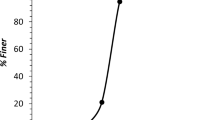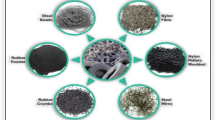Abstract
One of the major wastes from mining and automobile sectors is tailings and waste tires, respectively. Their voluminous nature calls for urgent action for safe disposal and to reduce the growing threat on the environment. Under the present study, laboratory model footing and toxicity characteristics leaching procedure (TCLP) tests were conducted on tire chip-reinforced copper tailings (TRCT) to explore the feasibility of its use as structural fill and its potential impact on surroundings. Parameters considered for the laboratory study were tire chip quantity, relative density of copper tailings and depth of reinforced zone. The test results indicate that there is a significant enhancement in bearing capacity of copper tailing at all the studied strains by the addition of waste tires. Bearing capacity increased by more than nine times compared to unreinforced tailings when reinforced with 30% tire chips by weight. The TCLP tests conducted on copper tailings established that concentrations of the leached elements were well below the regulatory standards. Furthermore, a neural network model was trained via the experimental results of the tests to quickly predict the bearing capacity of TRCT for quick use in field applications. Therefore, the proposed technique can help in the effective waste management and safe disposals of large quantities of copper tailings as well as waste tires and also promoting sustainability in construction.


















Similar content being viewed by others
References
Abu-Farsakh, M., Chen, Q., & Sharma, R. (2013). An experimental evaluation of the behavior of footings on geosynthetic-reinforced sand. Soils and Foundations,53(2), 335–348.
Ahmed, I. (1993). Laboratory study on properties of rubber soils. Report No. FHWA/IN/JHRP – 93/4. West Lafayette, IN: Purdue University.
Amari, S. I., Murata, N., Muller, K. R., Finke, M., & Yang, H. H. (1997). Asymptotic statistical theory of overtraining and cross-validation. IEEE Transactions on Neural Networks,8(5), 985–996.
Anbazhagan, P., Manohar, D. R., & Rohit, D. (2017). Influence of size of granulated rubber and tire chips on the shear strength characteristics of sand–rubber mix. Geo-Mechanics and Geo-Engineering,12(4), 266–278.
ASTM D-6270. (2012). Standard practice for use of scrap tires in civil engineering applications. West Conshohocken, PA: ASTM International.
Atta, K. F., Kumar, S. S., Daryoush, H., & Monir, K. (2016). Load- settlement behaviour of a strip footing resting on iron ore tailings as a structural fill. International Journal of Mining Science and Technology,26(2), 247–253.
Attom, M. F. (2006). The use of shredded waste tires to improve the geotechnical engineering properties of sands. Environmental Geology,49(4), 497–503.
Azam, S., & Li, Q. R. (2010). Tailings dam failures: a review of the last one hundred years. Geotechnical News,28(4), 50–53.
Balunaini, U., & Prezzi, M. (2010). Interaction of ribbed-metal-strip reinforcement with tire shred–sand mixtures. Geotechnical and Geological Engineering,28(2), 147–163.
Balunaini, U., Prezzi, M., Mohan, V. K. D., & Salgado, R. (2014a). Shear strength of tire chip–sand and tire shred–sand mixtures. Proceedings of the ICE—Geotechnical Engineering,167(6), 585–595.
Balunaini, U., Yoon, S., Prezzi, M., & Salgado, R. (2014b). Pullout response of uniaxial geogrid in tire shred–sand mixtures. Geotechnical and Geological Engineering,32(2), 505–523.
Bastos, L. A. C., Silva, G. C., Mendes, J. C., & Peixoto, R. A. F. (2016). Using iron ore tailings from tailing dams as road material. Journal of Materials in Civil Engineering,28(10), 1–9.
Bernal, A., Salgado, R., Swan, R. H., Jr., & Lovell, C. W. (1997). Interaction between tire shreds, rubber–sand and geosynthetics. Geosynthetics International,4(6), 623–643.
Blight, G. (2009). Geotechnical engineering for mine waste storage facilities. London: CRC Press.
Bussière, B. (2007). Hydro-geotechnical properties of hard rock tailings from metal mines and emerging geo-environmental disposal approaches. Canadian Geotechnical Journal,44(9), 1019–1052.
Chesner, W. H., Collins, R. J., & MacKay, M. H. (1998). User guidelines for waste and by-product materials in pavement construction. Report No. FHWA-RD-97-148, Washington, DC: U.S. Department of Transportation, Federal Highway Administration.
Dhir, R. K., Brito, J., de Mangabhai, R., & Lye, C. Q. (2017). Sustainable construction materials: Copper Slag (2nd ed.). Wood head Publishing Series in Civil and Structural Engineering, eBook-ISBN: 9780081009888; Hardcover ISBN: 9780081009864.
Edil, T., & Bosscher, P. (1994). Engineering properties of tire chips and soil mixtures. Geotechnical Testing Journal,4(14), 453–464.
Edil, T. B. (2008). A review of environmental impacts and environmental applications of shredded scrap tires. In Proceedings of the international workshop on scrap tire derived geomaterials, Yokosuka, Japan, 23–24 March 2007.
Edinçliler, A., Baykal, G., & Saygili, A. (2010). Influence of different processing techniques on the mechanical properties of used tires in embankment construction. Waste Management,30(6), 1073–1080.
Fang, Y., Gu, Y., Kang, Q., Wen, Q., & Dai, P. (2011). Utilization of copper tailing for autoclaved sand–lime brick. Construction and Building Materials,25(2), 867–872.
Foose, G. J., Benson, C. H., & Bosscher, P. J. (1996). Sand reinforced with shredded waste tires. Journal of Geotechnical Engineering,122(9), 760–767.
Ghazavi, M., & Sakhi, M. A. (2005). Influence of optimized tire shreds on shear strength parameters of sand. International Journal of Geomechanics,5(1), 58–65.
Gill, G., & Mittal, R. K. (2019). Use of waste tire-chips in shallow footings subjected to eccentric loading—An experimental study. Construction and Building Materials,199, 335–348.
Gupta, R. C., & Thomas, B. S. (2013). A study on the optimum moisture content and maximum dry density of sandy and clayey soil stabilized by copper tailings. Research in Civil and Environmental Engineering,1, 123–138.
Harikumar, M., Sankar, N., & Chandrakaran, S. (2016). Behaviour of model footing resting on sand bed reinforced with multi-directional reinforcing elements. Geotextiles and Geomembranes,44(4), 568–578.
Hennebert, P., Lambert, S., Fouillen, F., & Charrasse, B. (2014). Assessing the environmental impact of shredded tires as embankment fill material. Canadian Geotechnical Journal,51(5), 469–478.
Hu, L., Wu, H., Zhang, L., Zhang, P., & Wen, Q. (2017). Geotechnical properties of mine tailings. Journal of Materials in Civil Engineering,29(2), 4016220–4016221.
IS:1498. (1970). Classification and identification of soils for general engineering purposes. Bureau of Indian Standards, New Delhi (Reaffirmed 2007).
IS:10500. (1991). Drinking water specification. New Delhi: Bureau of Indian Standards.
IS:2720-14. (1983). Methods of test for soils—Determination of density index for cohesion less soils. New Delhi: Bureau of Indian Standards.
Kumar, A., Ohri, M. L., & Bansal, R. K. (2007). Bearing capacity of strip footings on reinforced layered soil. Geotechnical and Geological Engineering,25(2), 139–150.
Latha, G. M., & Somwanshi, A. B. (2009). Bearing capacity of square footings on geosynthetic reinforced sand. Geotextiles and Geomembranes,27, 281–294.
Lu, X., & Wang, H. (2012). Microbial oxidation of sulphide tailings and the environmental consequences. Elements,8, 119–124.
Ma, G., Li, Z., & Wang, L. (2018). Printable properties of cementitious material containing copper tailings for extrusion based 3D printing. Construction and Building Materials,162, 613–627.
Mendez, M. O., & Maier, R. M. (2008). Phytostabilization of mine tailings in arid and semiarid environments—An emerging remediation technology. Environment Health Perspectives,116(3), 278–283.
Mittal, R. K., & Gill, G. (2017). Pressure settlement behaviour of strip footing resting on tire-chip reinforced sand. International Journal of Geotechnical Engineering. https://doi.org/10.1080/19386362.2017.1408195.
Mittal, R. K., & Gill, G. (2018). Sustainable application of waste tire chips and geogrid for improving load carrying capacity of granular soils. Journal of Cleaner Production,200, 542–551.
Moghaddas Tafreshi, S. N., Joz Darabi, N., Tavakoli Mehrjardi, G., & Dawson, A. (2019). Experimental and numerical investigation of footing behaviour on multi-layered rubber-reinforced soil. European Journal of Environmental and Civil Engineering,23(1), 29–52.
Moghaddas Tafreshi, S. N., & Norouzi, A. H. (2012). Bearing capacity of a square model footing on sand reinforced with shredded tire—An experimental investigation. Construction and Building Materials,35(2012), 547–556.
Moo-young, H., Sellasie, K., Zeroka, D., & Sabnis, G. (2003). Physical and chemical properties of recycled tire shreds for use in construction. Journal of Environmental Engineering,129(10), 921–929.
Mosallanezhad, M., Hataf, N., & Ghahramani, A. (2008). Experimental study of bearing capacity of granular soils, reinforced with innovative grid-anchor system. Geotechnical and Geological Engineering,26(3), 299–312.
Mudd, G. M., & Boger, D. V. (2013). The ever-growing case for paste and thickened tailings—Towards more sustainable mine waste management. AusIMM Bulletin,2, 56–59.
Nitish, K. K., Neglur, H., Balreddy, M. S., & Basim, S. C. (2013). Utilization of copper ore tailings and fly ash mix as road subgrade/embankment material. In Proceedings of Indian Geotechnical Conference, Roorkee, India (pp. 1–6).
O’Shaughnessy, V., & Garga, V. K. (2000). Tire-reinforced earth fill. Part 3: Environmental assessment. Canadian Geotechnical Journal,37, 117–131.
Ojuri, O. O., Adavi, A. A., & Oluwatuyi, O. E. (2017). Geotechnical and environmental evaluation of lime–cement stabilized soil–mine tailing mixtures for highway construction. Transportation Geotechnics,10, 1–12.
Oluwasola, E. A., Hainin, M. R., Aziz, M. M. A., Yaacob, H., & Warid, M. N. M. (2014). Potentials of steel slag and copper mine tailings as construction materials. Materials Research Innovations,18(6), 250–254.
Onuaguluchi, O., & Eren, Ö. (2012). Recycling of copper tailings as an additive in cement mortars. Construction and Building Materials,37, 723–727.
Reddy, S. B., Kumar, D. P., & Krishna, A. M. (2016). Evaluation of the optimum mixing ratio of a sand–tire chips mixture for geoengineering applications. Journal of Materials in Civil Engineering ASCE,28(2), 1–7.
Schroeder, R. L. (1994). The use of recycled materials in highway construction. Washington, DC: Public Roads, Federal Highway Administration.
Shahin, M. A. (2015). A review of artificial intelligence applications in shallow foundations. International Journal of Geotechnical Engineering,9(1), 49–60.
Shahin, M. A., Jaksa, M. B., & Maier, H. R. (2008). State of the art of artificial neural networks in geotechnical engineering. EJGE,13, 1.
Sienkiewicz, M., Kucinska-Lipka, J., Janik, H., & Balas, A. (2012). Progress in used tires management in the European Union: A review. Waste Management,32(10), 1742–1751.
Smith, G. N. (1986). Probability and statistics in civil engineering: An introduction. London: Collins.
Tatlisoz, N., Edil, T. B., & Benson, C. H. (1998). Interaction between reinforcing geosynthetics and soil–tire chip mixtures. Journal of Geotechnical and Geoenvironmental Engineering,124(11), 1109–1119.
Thomas, B. S., & Gupta, R. C. (2013). Strength and durability characteristics of copper tailing concrete. Construction and Building Materials,48, 894–900.
US EPA. (1992). Method 1311: Toxicity Characteristic Leaching Procedure (TCLP). Washington, DC: US Environmental Protection Agency.
Yadav, J. S., & Tiwari, S. K. (2017). The impact of end-of-life tires on the mechanical properties of fine-grained soil: A review. Environment, Development and Sustainability. https://doi.org/10.1007/s10668-017-0054-2.
Yaghoubi, M., Shukla, S. K., & Mohyeddin, A. (2018). Effects of addition of waste tire fibers and cement on the engineering behaviour of Perth sand. Geomechanics and Geoengineering,13(1), 42–53.
Yoon, S., Prezzi, M., Siddiki, N. Z., & Kim, B. (2006). Construction of a test embankment using a sand–tire shred mixture as fill material. Waste Management,26(9), 1033–1044.
WHO. (2003). Iron in drinking-water. Background document for preparation of WHO Guidelines for drinking-water quality (WHO/SDE/WSH/03.04/08). Geneva: World Health Organization.
Zheng, J., Zhu, Y., & Zhao, Z. (2016). Utilization of limestone powder and water-reducing admixture in cemented paste backfill of coarse copper mine tailings. Construction and Building Materials,124, 31–36.
Zornberg, J. G., Cabral, A. R., & Viratjandr, C. (2004). Behaviour of tire shred–sand mixtures. Canadian Geotechnical Journal,41(2), 227–241.
Acknowledgements
Authors are thankful to the Department of Civil Engineering, BITS Pilani, Rajasthan, India, for aiding the testing program. We are deeply grateful to the Editor and Anonymous reviewers for giving their valuable time and suggestions for improving the quality of the manuscript.
Author information
Authors and Affiliations
Corresponding author
Ethics declarations
Conflict of interest
The authors reported no potential conflict of interest.
Additional information
Publisher's Note
Springer Nature remains neutral with regard to jurisdictional claims in published maps and institutional affiliations.
Rights and permissions
About this article
Cite this article
Gill, G., Mittal, R.K., Dandautiya, R. et al. Sustainable utilization of waste tire-chips reinforced copper tailings as structural fill. Environ Dev Sustain 22, 4845–4865 (2020). https://doi.org/10.1007/s10668-019-00408-2
Received:
Accepted:
Published:
Issue Date:
DOI: https://doi.org/10.1007/s10668-019-00408-2




